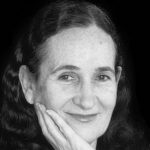READ ON TO DISCOVER:
- Why a physicist had her wedding ring launched into space
- How scientists finally figured out how stars shine
- Which crazy idea spawned a new era of cancer treatment
Safi Bahcall is a physicist turned biotech entrepreneur, and the author of the newly-selected Next Big Idea Club book, Loonshots: How to Nurture the Crazy Ideas That Win Wars, Cure Diseases, and Transform Industries. He recently sat down with his mother, renowned astrophysicist Neta Bahcall, to discuss his father’s legacy, and explore why groundbreaking ideas in science and business often take so long to catch on.
This conversation has been edited and condensed. To watch the full version, click the video below:
Safi: You’ve been working in astronomy ever since living at Caltech, and then from there you went to Princeton, and then for a few years you were at Baltimore.
Neta: At the Space Telescope Science Institute.
Safi: Do you want to talk a bit about the Hubble?
Neta: The Hubble Space Telescope was the first big, optical telescope to be put in space in order to observe the universe with very high resolution—and it has yielded immense scientific results. The Hubble is one of the biggest, most well-known telescopes ever built, and it’s closely connected to our family. [My husband] John [Bahcall] was one of the founders of the Hubble Space Telescope, and helped lead it from the early 70s. And I worked for several years as the chief scientist for the Hubble, which was a very exciting time.
When the last mission to repair the Hubble went up about ten years ago, astronaut John Grunsfeld was among the crew. He wanted to take something personal of John, because he said that if it was not for him, the Hubble would not be there. So I gave him our two wedding rings to take up with him to the Hubble.
I kept watching them online the whole time—they went around the earth two hundred times, and then came back. And now I’m wearing it.
When I tell that story, some people ask, “Weren’t you worried that the wedding rings would be lost, that he would not bring them back?” And I said, “Why should I worry if they got lost off in space? What a wonderful place for the wedding rings to be.”
“People realized that maybe Dad was right, and something about our laws of physics was wrong.”
Safi: That’s a great story. In some ways, Dad was a model for the kind of thing that I’ve just written about—a person who has an idea, and believes in that idea even though people make fun of it or don’t believe it. And not just for just a few months or a year, but for decades.
Neta: Almost 40 years.
Trending: How to Transform Daily Habits into Life-Changing Rituals
Safi: That’s right. You can tell that story, but I’m going to give a bit of background. In 1964, my dad published a paper that suggested a new idea for measuring how stars shine. For a long time, [it had been believed that] nuclear reactions powered stars, that stars shine by nuclear fusions—which are essentially giant explosions.
Neta: Like a hydrogen bomb.
Safi: Like hydrogen bombs, where helium atoms come together. That’s how the sun and stars in the universe were believed to shine, but we had no way of proving that. So in 1964, my dad published this paper [explaining that] nuclear reactions have these little byproducts, these tiny, massless particles called neutrinos. So if nuclear reactions really do power stars, we can calculate how many neutrinos [should be emitted and arrive on Earth]. And if you build a big mine and create a giant vat of fluid, you can [measure and compare the number] of neutrinos that you see.
But people said, “That’s crazy! The sun is so far away, and [neutrinos] are such tiny byproducts… There’s no way we could possibly do this.” But he convinced enough people, and they all designed the experiment and built the mine in South Dakota.
They did the experiment, measured [the number of neutrinos]… and the answer was off—by a factor of three.
And that was very disappointing for Dad, because he had done all the calculations, and built this whole theory. The experiment gave a result that was very different than what he had calculated, and he was pretty depressed about it.
But then he talked to [physicist Richard] Feynman at Caltech. What was that story?

Neta: They walked one day from the cafeteria back to the office, and Feynman told him, “You seem a little upset. What’s going on?” So John tells him that he calculated how the sun shines, and how many neutrinos to expect. It’s a big, very complex calculation, and [John said,] “I think I did a good job, but the experiment gives 3 times too few neutrinos. It’s the biggest research I’ve done so far—I’ve checked and rechecked it many times, and I don’t know what I did wrong.”
And Feynman tapped him on his back and said, “Don’t worry young man. If you checked it, you may be right, and the result may be right, and maybe there’s something important in the discrepancy.”
That was in the 60s. And for thirty years, nobody knew what was going on. It became known as the “solar neutrino problem”—but Feynman was right. At the end, this factor of three difference became a big discovery.
Safi: Right. Dad stuck to it because he had confidence that he was right, and then people realized that maybe Dad was right, and something about our laws of physics was wrong.
All the way until the late 90s and the early 2000s, people believed that neutrinos had no mass. And this experiment proved that, in fact, neutrinos have a mass. The factor of three difference is because there are three neutrinos, and as soon as neutrinos have a mass, they can rotate between all three of them—that’s why you’re only seeing one third of what you expected.
So that was an example of what we call a “loonshot.” It was an idea that was dismissed as crazy—that you could measure something in astronomy that would tell you something about the basic laws of particle physics. Now, it’s a whole field of astrophysics—two Nobel prizes were awarded for that. Unfortunately, Dad wasn’t around to be recognized, but I think he got the satisfaction of knowing that his theory was right, and that it changed our understanding of the laws of physics.
Neta: It changed the physics textbooks.
Safi: The story of Dad and solar neutrinos—where a person suggests an idea that people think is kind of nuts, and then he persists for three decades—it got me thinking about this pattern in science. People think that these great discoveries happen overnight—these brilliant geniuses have an idea, and then it’s widely recognized. But people who do science for a living [know that] that’s not really how it works. It’s often the most important ideas that are dismissed and ridiculed—not for a week, or a month, or a year, but for many years or decades, like in the case of Dad.
“It’s often the most important ideas that are dismissed and ridiculed—not for a week, or a month, or a year, but for many years or decades.”
That really came home to me when I started in biotech and drug discovery. Early on, I was introduced to a person named Judah Folkman, who was a surgeon at Boston Children’s Hospital, but transitioned from surgery to doing research.
Trending: 5 Reasons Life Gets Better After Your 40s
Right around the same time in the 60s that Dad suggested the solar neutrino, Judah suggested a crazy idea. His idea was that tumors, cancer cells, secrete stuff into the [surrounding] tissue, signals that cause new blood vessels to bring in nutrients and oxygen that help the tumor grow. And his idea was, [if] we have this signaling, let’s try to treat cancer by cutting off that signal.
That was a completely crazy idea. At the time, there were only two ways to treat cancer: burning it with radiation, or chemotherapy, which is poisoning the tumor by flooding the body with poisons, and hoping you don’t kill the patient. The idea that there was this mysterious signal that nobody knew about, that maybe tumors use, was considered nuts.
Judah spent three, almost four decades [championing his idea], but over and over people would say, “Your idea is crazy, the evidence doesn’t work, this experiment doesn’t make sense.” And he would patiently walk people through it, and redo the experiment.
And then in 2003—which was right around the time a solar neutrino experiment validated Dad’s original calculations—a drug that came out of his ideas was used in a large clinical trial in colon cancer—and it worked. It gave the best improvement in colon cancer patients’ survival that had ever been seen. Judah had been called a clown, had been asked to resign, so this was an enormous vindication.
Because Judah persisted, all of the treatments that underline new cancer drugs today are about signal blocking. Millions of patients are taking drugs that block signaling, and that all started with Judah.
It turned out that his idea worked not only for cancer, but also for the eye. His idea helps new blood vessels grow, and a fair amount of blindness is caused by abnormal blood vessel growth in the eye. So when you put the drugs that came out of his idea into the eye, you can reverse a certain kind of blindness. Millions of people have benefited from his ideas, and he’s now recognized as this rockstar scientist—but it didn’t happen overnight. It took 30 or 40 years.
There’s a parallel between Dad’s story and Judah’s story, and that gave me a sense that the truly important ideas are the ones that are dismissed or ridiculed, sometimes for decades.

And it’s not just these two stories—there are many in astronomy. A very interesting one is dark matter.
Neta: I work on dark matter, and that idea also took about 40 years [to catch on]. The original suggestion that there is dark matter, and a lot of it, was suggested by a famous Swiss astronomer [named Frtiz] Zwicky. I met him in the 60s when I was a graduate student at Caltech, and he was very eccentric.
In the 1930s, he had claimed that based on his observations, there must be a lot of dark matter in the universe. He measured the motion of galaxies in big clusters, and he said, “They are moving very fast, and they cannot be contained unless you have a lot of dark matter to hold them together.” He called it the “missing matter problem.”
That was in the 30s, and until the 70s, top astronomers fought that idea, like with John and Judah Folkman. They didn’t believe in it, and they had some scientific arguments why, but ultimately, Zwicky was absolutely right. It took 40 years, during which people did not pay the idea much attention to the idea other than to complain about it, but new measurements in the 70s showed [support for Zwicky’s ideas].
Safi: Was he still alive?
Neta: No, he was not alive for that. But he knew he was right, and he was beautifully confirmed with the total amount of dark matter that he measured.
Trending: 5 Simple Strategies for Persuading Anybody
Safi: Fortunately, Dad lived to see the triumph [of his ideas].
Neta: When the results were found in 2001 that showed his calculations were exactly right, they had a video interview of your dad, and they asked him, “How did you feel when this result was announced?” He said, “I felt like dancing. For 35 years, I felt as if I was somehow convicted of this heinous crime. And then all of the sudden, some DNA results came out, and showed that I was innocent.” That’s how he felt.
Safi: I’m sure that exactly how Judah Folkman felt.
[Speaking of] astronomy, today it seems obvious that the Earth goes around the sun, but it was only in the last couple hundred years that [people knew this]—people once thought it was the other way around.
“Kepler, Copernicus, Galileo, and Newton showed that we don’t have to listen to these divine rulers—we can identify truth and measure it for ourselves.”
The idea [that the Earth went around the sun] had been floating around—and been dismissed—well before Copernicus suggested it. He borrowed a lot of science and mathematics from Islamic astronomers and Indian mathematicians, but when he proposed the idea, no one paid attention—it was dismissed as ludicrous. People think the Church suppressed it, but that actually wasn’t the case. He was a pretty devout Catholic, and the Church encouraged him. It wasn’t until 100 years later, when Galileo attacked the Church in a kind of obnoxious way, that the Church [took issue with the idea].
But at the time, no one paid much attention [to Copernicus’ suggestion]—it was considered silly. Because if Earth is spinning really fast, [they thought,] why aren’t birds flung from their nests? So Copernicus first suggested the idea around 1510 and published it in 1543, but it wasn’t a viable theory until Kepler [worked on it] in the early 1600s. That’s when people started taking it seriously—but it took from 1510 to 1600, about 100 years. And then it took another two or three decades before people accepted that it worked even better than the previous theory.
That was the mother of all loonshots, because it changed not only how we think about the universe, but it changed how we, as a society, think about truth. Up until then, leaders and divine rulers said that gods in the sky determined the world. And Kepler, Copernicus, Galileo, and Newton showed that we don’t have to listen to these divine rulers—we can identify truth and measure it for ourselves. In many ways, it democratized the very idea of truth. And that launched a revolution, the Scientific Revolution, which led to our modernization over the last few hundred years.
Neta: It also changed our understanding of our position in the universe, because it showed that we on planet Earth are not the center of anything. We are just one planet going around the sun, and the sun is just one of billions of stars in the galaxy.
Safi: [It took] about four decades for Dad’s idea to change the laws of physics, and four decades for Judah Folkman’s idea to change cancer treatment. But it was more like ten or eleven decades for Copernicus’ idea [to catch on].
So that’s the theme—a lot of people think that these great ideas [succeed right away,] but they really take decades. We’re talking about big ideas in astronomy, but [this is just as true] in the business world. When people first invented the transistor, they had no idea what to do with it. It took five years for its first use—in hearing aids. Now the transistor [is central to] radios, computers, and more.
These big ideas often arrive with all these complications and problems—that’s why they’re so easy to dismiss. Copernicus’ idea and Judah Folkman’s idea had all these flaws. The early calculations that Dad made [begged] all sorts of valid questions. They took years, and then they changed the world.
Ready to dive into Safi’s new book? Join the Next Big Idea Club today!





























